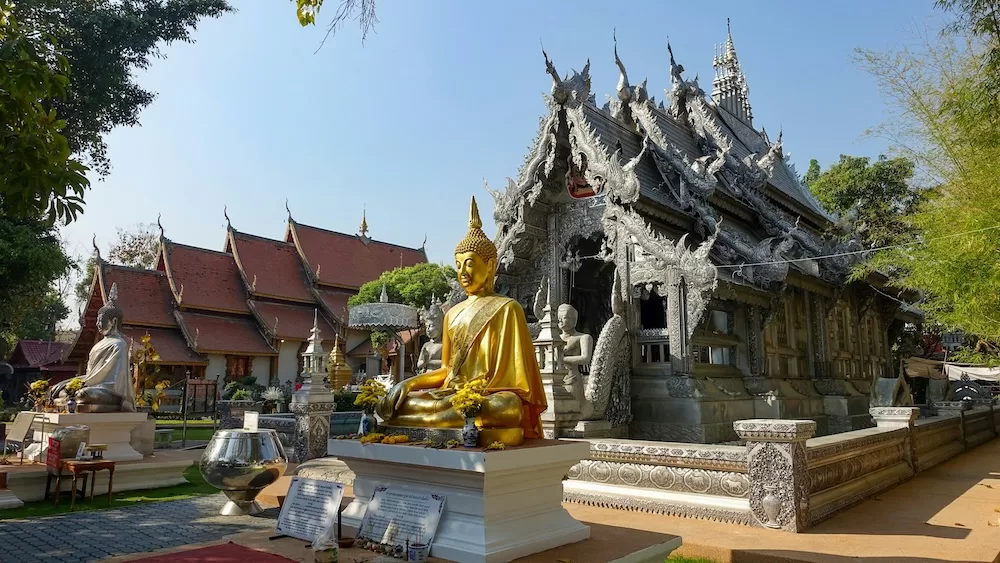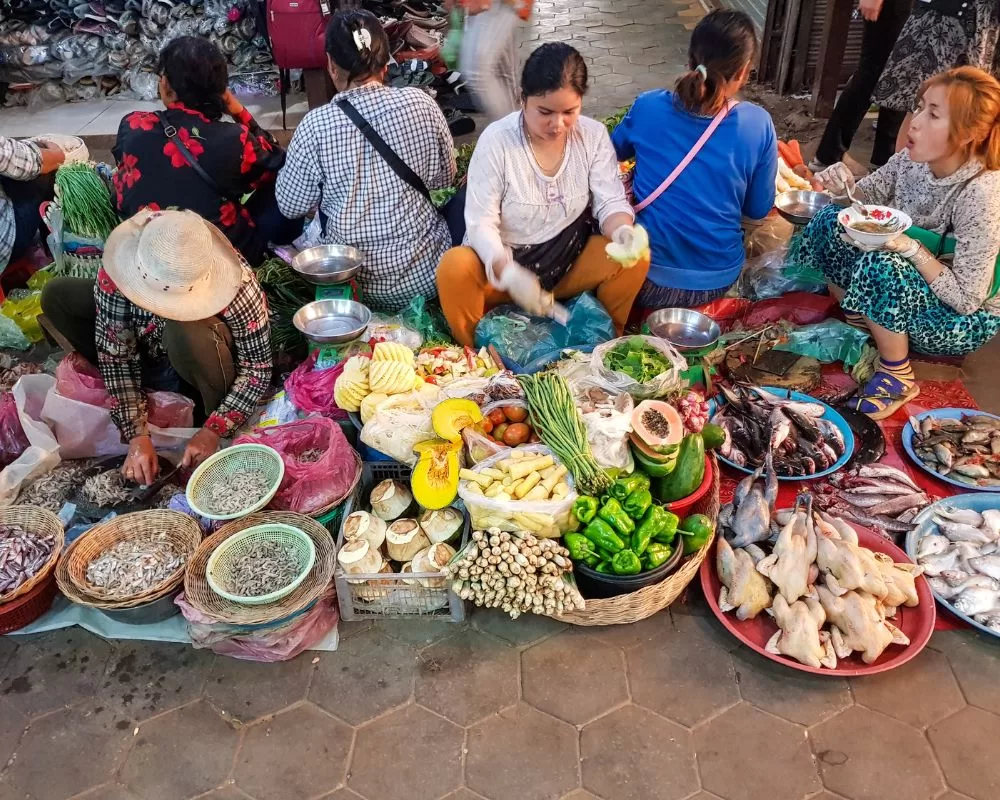
Cambodian Cuisine: A Culinary Adventure
Cambodian food, whilst not as well known as that of neighbouring Thailand and Vietnam, is a complex, flavourful and ethnically diverse cuisine. To some extent, Cambodian cuisine is similar in concept to that of Vietnam and Thailand. However, Khmer traditional food is distinct and offers a bit of every flavour.
Drawing upon centuries of influence from Indian traders, French colonialists, Chinese migrants and Vietnamese occupiers. Cambodian cuisine is a fusion of indigenous ingredients that has been shaped by the country’s culture and history, not only in the form of French-style baguettes but also in buns and other baked goods.
As with most of Asia, rice is Cambodia’s dietary staple, consumed at all meals. However, the Mekong River provides ideal growing conditions, for freshwater fish, crustaceans, molluscs, and edible plants that are all key components of Cambodian food. Equally important are spice pastes (kroeung), fermented fish paste (prahok) – which adds a salty/savoury component, palm sugar (khaw), and a wide variety of herbs. Like other Southeast Asian cuisines, Cambodian food is a balance of sweet, bitter, sour and salty flavours, although it’s markedly less spicy than Thai and Laotian food.
In order to fully experience Cambodian food, you need to fully embrace the food challenges. You will be introduced to all manner of offal, rodents, insects and arthropods as part of the Cambodian diet. If you think this is only truly traditional Cambodian food from the country, you are mistaken. This is eaten in the capital of Phnom Penh and throughout the country. The latter are generally consumed as snacks, but you’ll also find them as the protein component in main dishes.
So while in Cambodia, don’t miss the chance to check out our list of the best Cambodian foods that you should taste and discover these unique flavours.
Check out our Cambodia Travel Itinerarys and Guides.
Cambodian Khmer Cuisine
Khmer cuisine is profoundly influenced by water, rice and freshwater fish due to Cambodian geographical location and climate. Typically, Cambodians eat their meals with at least three or four dishes. A meal will usually include rice – the staple food in Asian cuisines, a soup (locally known as samlor), served alongside the main courses. Each dish will be either sweet, sour, salty or bitter. Chilli (either fresh, pickled or dried) and chilli sauce are served on the side so that diners can add it up as their personal preference.
The hallmark of Khmer cuisine is prahok, a fermented paste made from a small fish called trey riel, grey or brown in colour, with a strong odour and an intense flavour. It is used both as a condiment and as a main element in a variety of Khmer dishes, and it accounts for a large portion of protein in the Khmer diet. Another foundation of many Cambodian dishes is Kroeung, a distinctive spice paste made with a base of lemongrass, kaffir lime and galangal.
Traditional Khmer Food
Khmer cuisine has combined these elements with a distinct set of flavours and ingredients to form a unique taste. Listed Below are the key ingredients found in every Khmer cook’s palette:

Galangal is a light-coloured root that resembles ginger, although the flavour is much milder. It is often ground into a paste before being added to a dish.
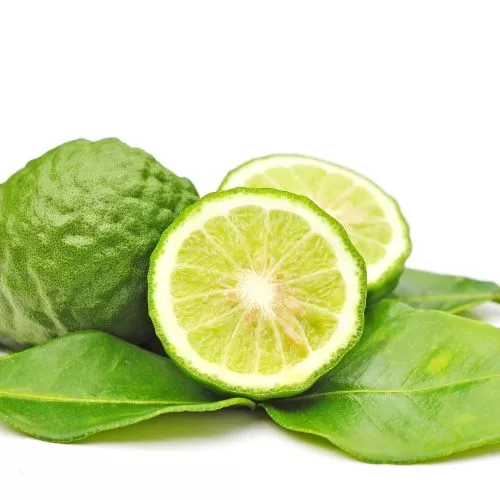
Kaffir lime is native to Indonesia and Malaysia. Its rind and leaves are ground and added to curries, soups and salads, lending a pungent, lemony flavour and deep green colour.
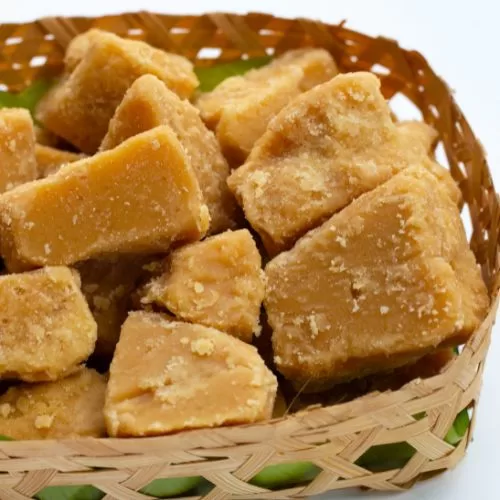
Palm sugar is reduced from palmyra or sugar palms. It has a richer, earthier flavour than cane sugar. It comes in solid, golden blocks or packed in jars, and can easily be crumbled or melted.
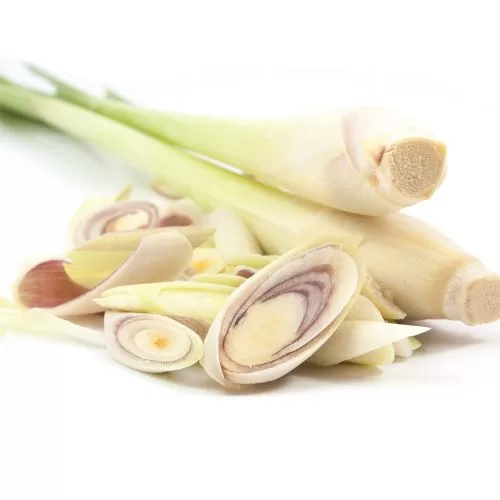
Lemon grass has a distinctive balmy, lemon flavour.

Prahok is a grey, fermented fish paste, with a pungent, salty flavour. It is used as a seasoning, condiment, or even primary ingredient.
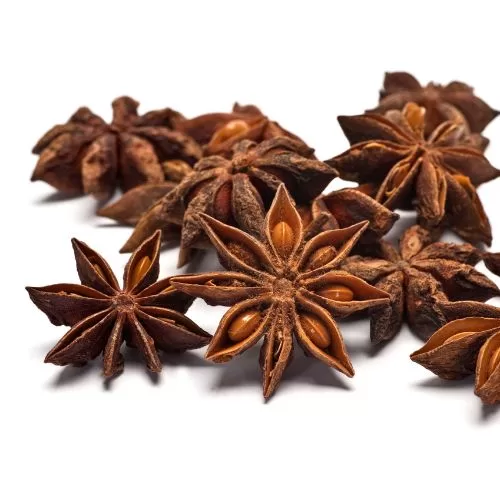
Star anise is native to China and is used in caramelised meats. It is also used medicinally as an aid to digestion.
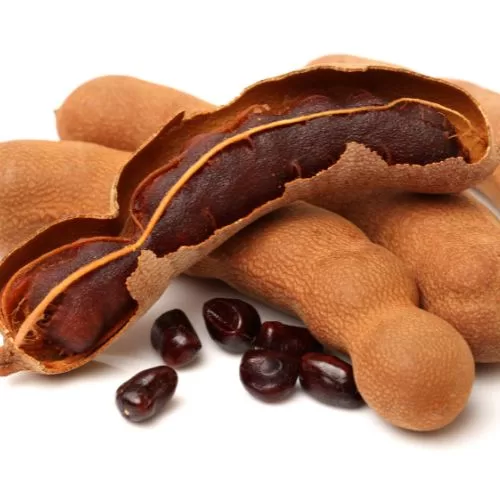
Tamarind is a dark, sticky fruit native to tropical Africa. It hangs from the tree in long pods, with a thin layer of sour fruit surrounding a string of hard, black seeds. It was brought to Indochina by Indian traders long ago and is commonly used to darken or sour soups and sauces.

Turmeric is a rhizome that is ground and added to curries to give a rich, orange colour. It has a faint, bitter flavour and a distinctive, mustard-like smell.
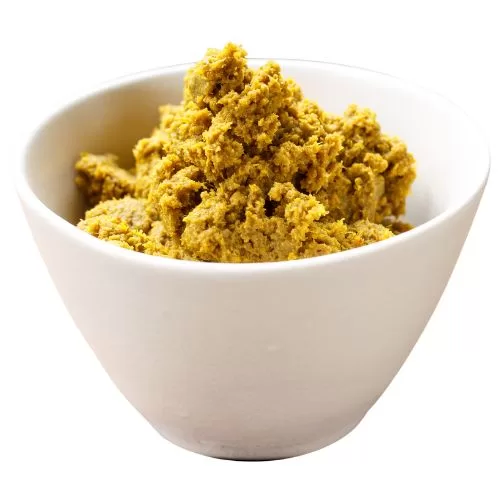
Finally, kroeung, or curry paste, forms the base of many Cambodian dishes, including the famous amok. It comes in green or red (cham pour seeds are added to give the red colour). The mix typically includes kaffir lime, galangal, turmeric, prahok shrimp paste, shallots and garlic.
Traditional Cambodian Dishes
Amok – Coconut Fish Curry
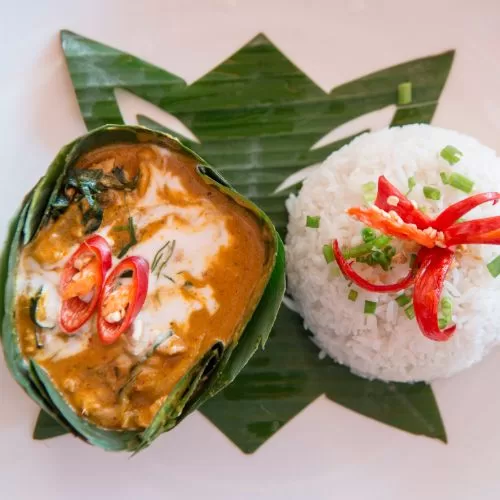
Being known as one of the most popular and signature dishes of Cambodia, fish amok can be easily found on menus in tourist hubs all over the country. Diced fillets of freshwater fish are smothered in a creamy curry-like sauce. Fish Amok Curry is a fragrant and spicy coconut fish curry tenderly steamed in banana leaves, which gives it a silky smooth texture which all but makes it melt in the mouth. The blended spice paste, kroeung, is also added to the dish. Amok chouk is another version made with snails steamed in their shells. Less traditional variations may use chicken or seafood, and be served as a thinner, creamy soup contained in coconut husks
Samlor Korkor – Traditional Cambodian Soup
While Fish Amok Curry is sometimes called the country’s signature dish, and very familiar to tourists, locals voted Samlor Korkor as the true national dish of Cambodia. This traditional Khmer soup has been eaten by Cambodians for hundreds of years and can be found in restaurants, roadside stands and family homes alike. This type of soup is rich in both flavours and nutrition. Samlor Korkor is made from a variety of seasonal vegetables and herbs, including unripe papaya and banana, pumpkin, long bean, eggplant, turmeric, moringa and kaffir lime leaves.
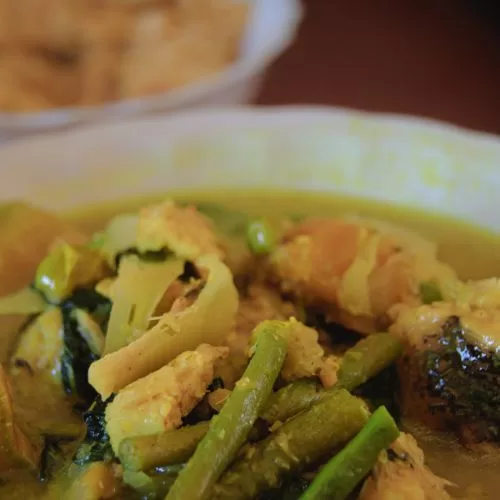
Nam Banh Chok – Khmer Noodles
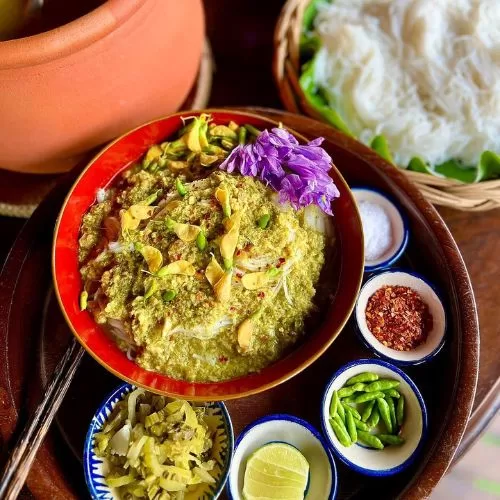
Nom banh chok is simply called in English “Khmer noodles”. num banh chok is a fish-based curry and noodles dish typically eaten at breakfast all over Cambodia. Regardless of regional variations, num banh chok always includes the same main staples: fresh rice noodles laboriously prepared by hand, a fish-based green curry, and spices and vegetables such as lemongrass, ginger, turmeric, and garlic. When enjoying this dish, eaters add fresh cucumbers, banana flowers, long beans, edible flowers and wild leaves on top. It’s simply delicious when served with a sweet sauce called “tuk paem” made from palm sugar and peanuts. There are many regional variations to the standard recipe; for example, people in Kampot like to use dried shrimp, coconut cream, and fish sauce, while those in Siem Reap use more garlic and serve with a sweeter fish sauce.
Khmer Red Curry
Cambodian red curry is less spicy than Thai curry and tends to include more herbs than spices, also milder and sweeter in taste. This rich but mellow dish contains coconut milk-based sauce, herbs and diced sweet potatoes, and other popular condiments like Cambodian curry paste – kroeung, garlic, shallots, turmeric and ginger. The recipes can be varied with fish, chicken or beef but the most popular version is served with chicken. Accompanied by fresh rice noodles, white rice or sliced bread, Cambodians serve this delicious dish at special occasions like weddings, ceremonies, and religious holidays.

Pepper Crab

The coastal town of Kep is famous for the freshest and finest crabs, which are caught daily and sold at the bustling Kep Crab Market. They are then cooked in little roadside restaurants, where the freshest of catches are fried, quickly cooked and simply flavoured with immature green peppercorns from Kampot and garlic chives. Pepper crab is one of the best dishes in Cambodia. You can find this savoury, peppery dish in tourist cities like Phnom Penh and Siem Reap. However, local shacks and restaurants in Kep Crab Market is the obvious place to find the best-peppered crabs.
Beef Lok Lak
Beef lok lak is a renowned Khmer dish that has gained popularity among tourists visiting Cambodia. While the exact origins of Cambodian beef lok lak remain uncertain, it is believed that this dish emerged from Vietnam during the French colonial period. Making this dish relatively newer compared to the traditional Cambodian fish amok. “Lok lak,” which translates to “shaked beef”, draws an analogy to the cook’s skilful manipulation of his wok to ensure that all sides of the sliced beef are perfectly cooked.
Beef lok lak is a classic Khmer dish made using stir-fried strips of tender beef served on a bed of lettuce, sliced tomatoes, cucumbers and rings of raw onions. It’s often served with fried egg on top and a portion of rice on the side. The signature of this dish is the dipping brown sauce made by lime juice and Kampot peppers, which make the flavour truly savoury.
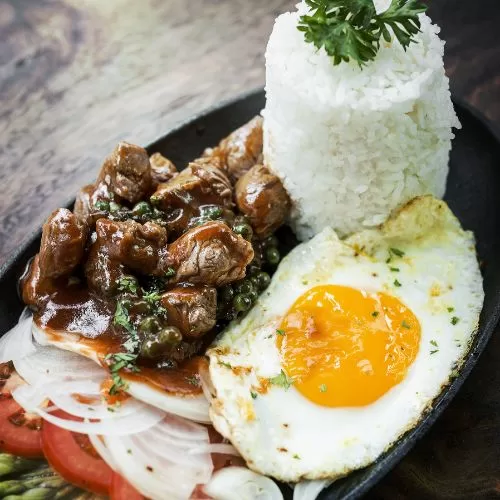
Cambodian Street Food
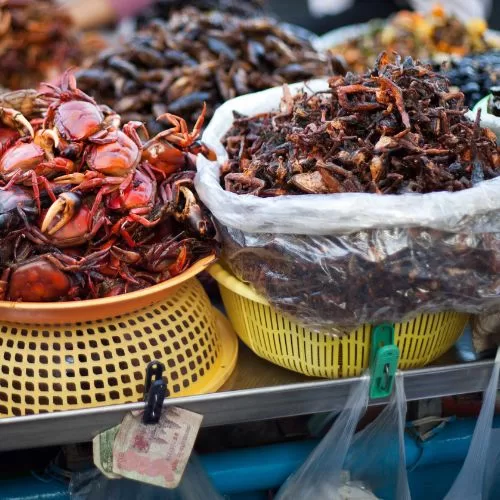
Cambodian street food is an important part of the social fabric, which is intrinsically linked to eating. Some traditional Cambodian street food you should try are nom pao – steamed, seasoned pork buns similar to Chinese bao. Sugar cane juice and Khmer coffee – iced or hot, it’s mixed with condensed milk and utterly addictive. Stir-fried noodles, fruit shakes, grilled meats and seafood are but a few things you will find at street food vendors … or even fried insects. You will most likely see local peddlers selling fried insects such as tarantulas, crickets, cockroaches and locusts. During the Khmer Rouge regime, many Cambodians had no choice but to eat insects to survive due to severe starvation. Gradually, the practice of eating insects has become a tradition and fried insects are a street food staple in this country.
Regardless of whether you are a meat lover or a vegetarian, Khmer cuisine has something for everyone. Boasting rich flavours and fresh ingredients Khmer food is a must-try for anyone visiting Cambodia.
Essential Travel Toolkit
🚖 Rideshare Apps – The most complete guide to Rideshare, Ride-hailing and taxis in Southeast Asia.
🚞 12Go.com – The easiest way to book transport, public or private in Southeast Asia, Japan and Beyond.
🏨 Trip.com – Consistently great accommodation and hotel deals.
🛩️ Trip.com – Get the best flight deals.
🚙 Trip.com – Find your perfect rental car.
🗺️ Getyourguide.com – Looking for an amazing local guide or tour. Get Your Guide will have something for everyone.
🗺️ Viator.com – Easily book tours and experiences at the lowest rate. Amazing options all over the world.
👨💻 NordVPN.com – Reliable VPN service that is guaranteed to keep you and your data safe anywhere in the world.

Wendy is a traveller, writer, and photographer with an insatiable curiosity for the world. Her journey, spanning South Africa, the UK, and now Australia, infuses her work with a rich tapestry of experiences. Join her on Getting Lost Again as she shares her creative perspective and passion for overland travel alongside Dan.

